Golden perch might not have the prowess and cult following that their bigger cousins the Murray cod have, but they are way more common, regularly encountered, targeted more, caught more and most importantly, they are more widely spread around the country.
I’m all about the adrenalin rush of sportfishing and promote and practice catch and release with all the natives that I catch. These magnificent and often prolific little natives go great on the plate as well. More often, this is why most people target them. Add to this the fact that golden perch are a schooling fish and when the right strategy or technique is used on the right day, you can catch massive numbers. Days with 50+ fish are more than possible.
It’s easy to see that if you don’t already specifically target them, then you have been missing out on a heap of fun. Golden perch fishing has become very popular all over the country. This is largely due to the tournament scene where golden perch now make up the most targeted species in freshwater tournament fishing – something many bass anglers said would never happen.
My love of golden perch started way before the tournament scene came alon,g but once it did I went and fished a bunch of these competitions. I was lucky enough to have won a lot of them. Here’s a heap of helpful hints, tips and tricks that helped me to win as well as land crazy numbers of these golden delights. These tactics should help you be more confident and catch golden perch more regularly, no matter where you fish around the country.
Having had several golden perch in a massive aquarium at home for many years, I took great interest in their habits and moods to help me become a better angler. One of the standout things I noticed about golden perch was that when it came to feeding, they really only liked to hit and eat bait like yabbies or worms as they were sinking to the bottom, either as you put a yabby in or when it would kick and then free fall back to the bottom.
Around 90% of the time, if the bait got their attention but didn’t get eaten or hit on the drop, they would hover right over the top of it for up to ten seconds then they would quickly lose interest. This alone is one of the main reasons that hopping lures works so well.
I made another key observation of my pet golden perch when I added baitfish of any description to the tank. I did my own tests and would make sure my goldens were as full as possible before the release of my baitfish, but even when full, the goldens knew if any of the released baitfish were wounded or dying. These would be devoured as soon as they were released into the tank. The fit and healthy baitfish were left alone until the goldens became really hungry again.
It was with these observations in mind that I sought out the right lures and then employed some retrieval strategies to help replicate what I observed and catch more golden perch in the big water. What I wanted from the lures and the way I worked them was to try and replicate either a fleeing yabby or shrimp or a dying baitfish. Whichever of these they take it for, it is a natural instinct of predatory fish like golden perch to eat anything that is dying or fleeing, whether the fish is full or not. I have caught countless fish over the years that are that full they have food items hanging out of their mouths and they still tried to eat my lure, due to exploiting these fishes’ natural instinct.
Having a good quality sounder can save you time locating, but it is not essential for success. I have never owned and still don’t own a good quality sounder but I never struggle to catch golden perch. I go off the topography of the land above the water and reflect on my own experiences and observations to help me to choose the right area. I then find the fish with my lures. These days if you have a good quality sounder and you know how to read it you don’t have to go off the method that I use. You can just sound around until you find fish then employ the techniques I’m about to explain.
The technique of hopping lures for golden perch or any predatory species can be as simple or as difficult as you like. If the fish are really on, a simple 50-100cm lift and drop that replicates a dying or fleeing baitfish, yabby or shrimp will catch fish, whether you keep in touch with your lure or not. On tough days there are a few things you need to do right to get fish to the boat. Honestly, if you don’t get it just right, you won’t catch fish. If you get it right, often on those ‘tough days’ anglers around you can be catching nothing while you catch a fish almost every cast.
Searching for golden perch on any new day or a new session, I start by sitting my boat in about 30-35ft of water. I cast to the bank and hop my lure back out to right under the boat to try and find where the most fish are holding. Some days they spread out from the bank all the way to 35ft of water, whereas on other days they will be concentrated at one particular depth.
I have found that year round the fish sitting close to the bank are quite active and are there for a reason – to feed. They actually seek out anything that looks like food, so the first few hops from the bank I like to make quite aggressive. Big and high hops get any active fish’s attention that hasn’t already seen it on the initial drop. I generally only let the lure sit for a split second on those first few hops and then as I get further out from the bank I start to pause the lure just a little bit longer between each hop.
The fish that are holding in deeper water are often a little less active and can take a little more work to get them to bite. So after the first few large hops close to the edge, it pays to make your hops smaller and less aggressive the further you get from the bank until you get the lure directly under your boat. Don’t give up on it once it’s under the boat, whether you can see fish on the sounder or not. Quite often after 20 or more small, gentle hops under the boat, a golden perch that was following or showing interest won’t handle the hopping lure in its face anymore.
Whether you are employing aggressive large hops or small gentle hops, the most important thing of all when using this strategy is staying in touch with your lure at all times, especially on the drop or as the lures fall back to the bottom after a hop. This is when most of the hits happen. When you feel that hit, which can be as obvious as a jerk of the rod if there is no slack in your line or like a subtle pluck or flick of your line if there is slack, you must strike to set the hook.
It never ceases to amaze me how quickly a fish like golden perch can smash and then reject a lure, so I must emphasise the importance of staying in touch with your lure at all times. In super windy conditions it may be difficult to detect bites with light lures. It pays to go to a heavier lure in this situation so that you can feel and strike on those hits.
On most days and most stages of the day, golden perch will be sitting predominantly in one main depth. If you are lucky, you will notice this on your flash sounder. You can also work this out while fishing and after a few fish are landed, especially if they are all caught at roughly the same depth.
If you find you are catching them all at one particular depth, it makes no sense to have your boat positioned in deep water or shallow water. By doing this and casting to or away from the bank, your lure will only be in the zone for a few hops. That doesn’t give you that much time to elicit a strike.
Say you find that the fish are sitting in 15ft of water, position your boat to sit in 15ft of water and make casts parallel to the bank in that depth, not to close or too far from the bank. By doing this, you’ll be hopping your lure in the strike zone for the entire retrieve, giving you the absolute maximum chance of getting a fish to have a go at your lure.
Rubber vibes, blades, lipless crankbaits, plastics and skirted jigs are the only lures you will ever need for this type of fishing. I could go on about each of these lures for hours, but I will narrow it down to exactly what I use the most and have in my tackle box.
Blades and rubber vibes are the greatest lures by far for hopping as they are silent, sink quickly and are easy to stay in touch with when fishing deep. I recommend ZX style blades, as these work and look the most realistic out of the blade styles on the market.
Rubber vibes are possibly even better, due to the rubber. These feel much more realistic to the fish and they will often keep hitting your rubber vibes until you finally hook them or they manage to hook themselves. I use Insanity Tackle Mini and Mega vibes. These 45mm 13g vibes replicate the fleeing and dying action we want. Goldens just can’t get enough of them. With vibe sizes and weights, pick the right lure for the right depth or the right wind conditions.
Early in the season, when the water clarity is poor or when you are searching large areas of active fish, a rattling lipless crankbait can outfish silent lures. The hopping action with the extra rattle can draw fish in from much further than a silent lure, and can be beneficial.
The plastics and skirted jigs are standouts when fishing late in the season, when fishing highly pressured waters and when fishing in super clear water. There are so many of each on the market. As long as you keep your presentation under 4” and preferably around 2”, you will catch plenty of golden perch hopping these lures.
It is up to the individual which rod and reel setup to use. I like to use my trout spin gear for this type of fishing, and light baitcast gear can also be used. If the fish are being a bit tight-lipped, I will run a 6lb fluorocarbon leader. If I’m fishing around timber, I will opt for 14lb fluorocarbon leader, and I find this is more than enough to handle even the most oversized golden perch you are ever likely to come across.
When the fishing gets super tough, it’s all about the hang time. Fish mostly hit your lure as it is sinking back to the bottom, so it makes sense to try and make this part of the retrieve last the longest.
The way I do this is by slowing the sink rate of the lure between hops as much as I can while still making it look natural. After a hop, with your rod as the controller, you need to hold your lure up just a little bit to slow the sink rate. You have to find a happy medium as you still want it to fall naturally, but you are trying to make this last just a tiny bit longer than it would if you just let it free fall under its own weight. Big golden perch are a bit slow and this extra half a second or so of hang time can give them the time they need to suck down your lure. It can be the difference between catching plenty and catching none.
I don’t use attractants and scents very often, but when working lures slowly like this, it can be of great benefit. I don’t believe it helps at all when searching and moving over large areas, but when hopping an area you know has fish, something as simple as adding some attractant can make all the difference.
Swinging and fixed assist hooks are a great tool to help you get more bites when hopping lures in weedy or slimy areas. Lakes like Windamere Dam in NSW are a perfect example. There is a lot of debate over the pros and cons of rigging your lures with assists. If you cast a double treble lure into weed or slime it gets fouled up. Not only will you not catch a fish with weed all over your lure, but you’ll scare any fish that are in the vicinity.
The same lure cast in the same areas with assists might not have the hook-up rate of the double treble, but you get fouled up far less. You’ll get more hits and therefore more fish, due to your lure being more fishable than it is with double trebles. One other pro for the assists is that once a fish is hooked you will lose far less fish than a lure rigged with double trebles.
These strategies and tips are sensational year-round techniques that work on golden perch and also work well on pretty much every predatory fish that swims in fresh and salt water. The super slow hang time technique is worth practicing, as once you master this, you’ll find that even on the toughest of days you will still be able to boat some fish. This tiny one percenter surprisingly can make 100% difference in your catch rate.
I employed this technique while targeting barramundi for the first time at Hazelwood Pondage and landed nine fish. I lost just as many on the jump and had dozens of other hits while the people I was fishing with and those all around me where catching nothing. The other anglers were using the exact same lures as me, fishing the same areas and were trying to use the same hopping technique, but none of them were slowing that sink rate down. This tiny thing was what made all the difference on this highly-pressured waterway.
Golden perch are an underrated fish that were considered just a springtime species. Now that anglers have clued onto some great strategies to catch them and use more sporting gear when targeting them, they have turned into a year-round sportfishing proposition. If you happen to struggle with this species, I hope this article has given you some tools to put into your box of tricks to help you next time you’re out on the water in hunt of some gold.
Reads: 7099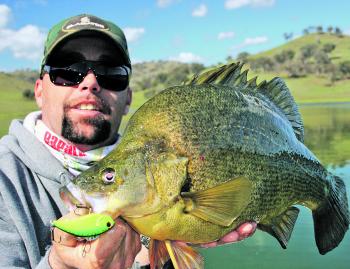
Early in the season, in dirty water and when searching large areas, it’s hard to beat a good rattling lipless crankbait.
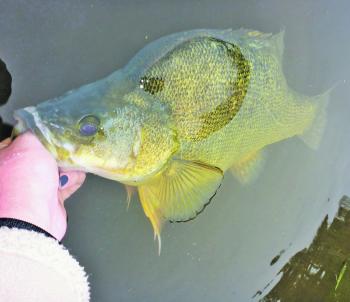
Look after these little battlers. For some of us, releasing these magnificent fish is as good as catching them.

A light spin rod is all you need for this type of fishing. If you are fishing around a lot of timber, a heavier spin rod or light bait cast setup might save you a few bust-offs.

On good day, using the hopping technique you will get good solid hook-ups like this. On other days, it’s all about striking to set the hooks.

The author caught this beast of a golden perch fooled by a Slap Walker from a bed of thick weed. Without the assist hooks to get through the weed, catching this fish wouldn’t have been possible.
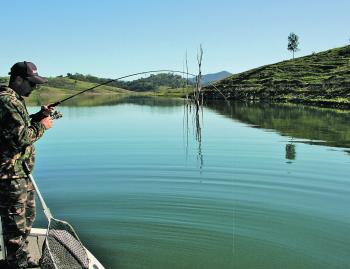
This area is a prime place to do some bottom bouncing. It has everything a golden perch could ask for – rock, weed, bays, trees, depth and some shallow bays to feed in.
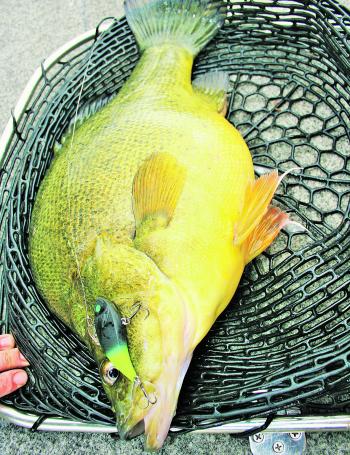
Using the right techniques will help you put the net under more and more of these footballs.
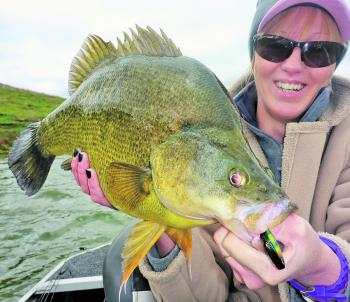
Catching good numbers of fish like this will make anyone smile.
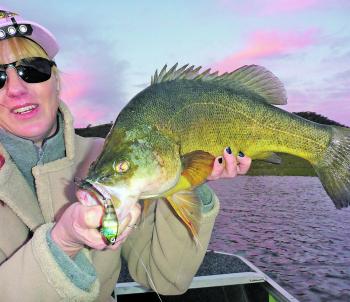
Rubber vibes rigged with a swinging single assist hook – if you are fishing places like Windamere Dam in NSW, which is full of weed and slime, you’ll need a bunch of these.
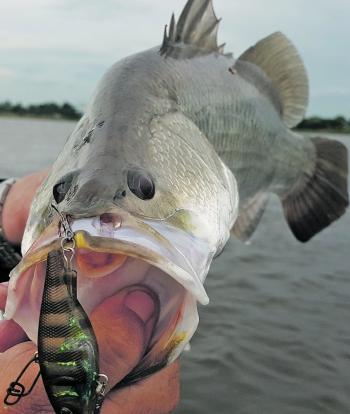
The techniques and tips in this article work on a whole host of fresh and saltwater species.




